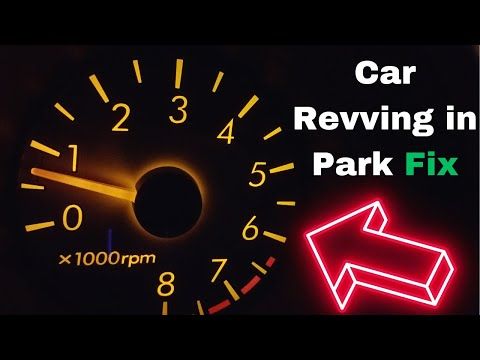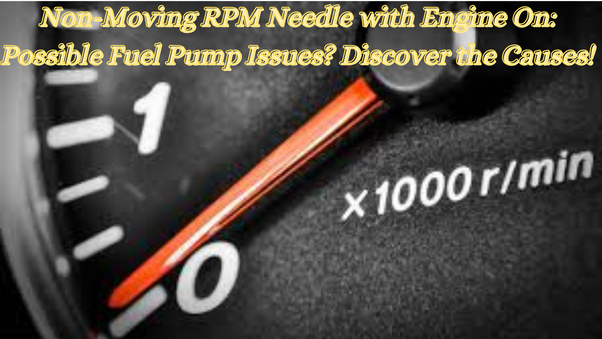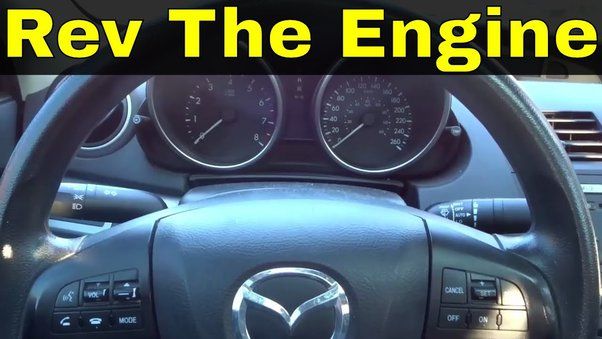


Maintaining a vehicle's engine in optimal condition is crucial for ensuring its longevity and performance. One concerning behavior that car owners may encounter is the engine revving unexpectedly while the vehicle is stationary, a phenomenon commonly referred to as "revving in park." This issue can arise due to various underlying causes and, if left unaddressed, can potentially lead to significant damage to the engine and its components.

When you shift your car into park, the engine should idle smoothly and maintain a consistent RPM (revolutions per minute). However, if you notice the engine revving up and down erratically, it's a clear indication that something is amiss. This irregular revving behavior can be caused by various factors, ranging from simple vacuum leaks to more complex issues with the engine's sensors or even the transmission.
Here are the most common reasons for a car revving up while in park:
| Cause | Description |
|---|---|
| Vacuum Leaks | Air leaks in the vacuum system can cause the engine to receive an incorrect air/fuel mixture, leading to erratic idling and revving. These leaks are often caused by cracked hoses, loose connections, or a faulty intake manifold gasket. |
| Faulty Idle Air Control (IAC) Valve | The IAC valve regulates the idle speed by controlling the amount of air bypassing the throttle body. If it gets stuck open or closed, it can cause the engine to rev up or down erratically when idling. |
| Dirty Throttle Body | A buildup of carbon deposits on the throttle body can restrict airflow, causing the engine to compensate by revving up and down. This is a common issue, especially in older vehicles with high mileage. |
| Faulty Throttle Position Sensor (TPS) | The TPS monitors the throttle position and relays this information to the engine computer. If it fails, it can send incorrect data, causing the engine to rev up unexpectedly. |
| Faulty Mass Airflow Sensor (MAF) | The MAF sensor measures the amount of air entering the engine. If it fails, it can cause the engine computer to miscalculate the required air/fuel mixture, leading to revving issues. |
| Faulty Engine Coolant Temperature Sensor | This sensor tells the engine computer the coolant temperature so it can adjust the air/fuel mixture accordingly. A faulty sensor can cause the mixture to be too rich or lean, resulting in revving. |
| Transmission Issues | In some cases, revving in park can be caused by problems with the transmission, such as a faulty torque converter or slipping gearbox bands. This is usually accompanied by other transmission-related issues. |
As a mechanic, I've learned that proper diagnosis is key to solving any automotive problem. When it comes to revving in park, here are the steps I typically follow:
Check for any stored diagnostic trouble codes using an OBD-II scanner. Codes can point to the root cause.
Visually inspect vacuum hoses, intake manifold gaskets, and throttle body for any cracks, leaks, or excessive carbon buildup.
With the engine idling, lightly cover the throttle body inlet with your hand. If the revving smooths out, the IAC valve may be stuck open.
Listen for any unusual sounds like hissing or whistling that could indicate a vacuum leak.
Vacuum Leak: Erratic idle, whistling/hissing sounds, engine stumbling
Faulty IAC Valve: Rough idle, stalling, high or low idle speed
Dirty Throttle Body: Rough idle, lack of power, black deposits visible in the throttle body
Faulty TPS: Rough idle, lack of power, difficulty starting, check engine light
Faulty MAF Sensor: Rough idle, lack of power, poor fuel economy, black smoke from exhaust
Faulty Engine Coolant Temp Sensor: Rough idle during cold starts, check engine light
Transmission Issues: Slipping gears, shuddering, check engine light related to transmission codes
Once I've identified the root cause of the revving issue, it's time to roll up my sleeves and get to work. Here are the typical repair instructions I follow for each potential problem:
Vacuum Leaks
Locate and replace any cracked or damaged vacuum hoses.
Replace the intake manifold gasket if it is the source of the leak.
Ensure all vacuum connections are tight and secure.
Faulty IAC Valve
Locate the IAC valve on the throttle body.
Disconnect the electrical connector and remove the valve.
Install a new IAC valve and reconnect the electrical connector.
Dirty Throttle Body
Disconnect the negative battery cable.
Remove the air intake duct and throttle body from the engine.
Use throttle body cleaner and a soft-bristle brush to remove carbon deposits.
Reinstall the clean throttle body and reconnect components.
Faulty TPS
Locate the TPS, usually on the throttle body.
Disconnect the electrical connector and remove the TPS.
Install a new TPS and reconnect the electrical connector.
Faulty MAF Sensor
Locate the MAF sensor, usually in the air intake duct.
Disconnect the electrical connector and remove the sensor.
Install a new MAF sensor and reconnect the electrical connector.
Faulty Engine Coolant Temperature Sensor
Locate the coolant temperature sensor, usually near the thermostat housing.
Disconnect the electrical connector and remove the sensor.
Install a new coolant temperature sensor and reconnect the electrical connector.
Transmission Issues
For transmission-related problems causing revving in park, it's best to have a professional transmission specialist diagnose and repair the issue.
Note: Always refer to the vehicle's repair manual for specific instructions and torque specifications.
To help prevent future revving issues and keep your car running smoothly, I recommend the following:
Follow the manufacturer's recommended maintenance schedule for fluid changes, filter replacements, and tune-ups.
Avoid excessive idling, which can lead to carbon buildup on the throttle body.
Use quality fuel and fuel injector cleaners to prevent deposits.
Check for any loose vacuum hoses or intake leaks during routine inspections.
Operate the vehicle gently and avoid excessive revving or lugging the engine.

The cost of repairs can vary depending on the root cause and the labor rates in your area. Here are some approximate costs for common repairs:
| Repair | Approximate Cost |
|---|---|
| Vacuum hose replacement | $50 - $150 |
| Intake manifold gasket replacement | $200 - $500 |
| IAC valve replacement | $100 - $300 |
| Throttle body cleaning | $100 - $300 |
| TPS replacement | $100 - $300 |
| MAF sensor replacement | $200 - $400 |
| Coolant temperature sensor replacement | $100 - $300 |
| Transmission repairs | $500 - $3,000+ (depending on the extent of damage) |
Keep in mind that these are rough estimates, and the actual cost may vary based on your vehicle's make, model, and the mechanic's labor rates in your area. It's always recommended to get multiple quotes from reputable repair shops or mechanics before proceeding with any repairs.
As an experienced mechanic, I've seen my fair share of cars revving in park, and I understand the frustration and concern it can cause for drivers. However, by understanding the potential causes, following proper diagnostic procedures, and addressing the issue promptly, this problem can be resolved.
Remember, regular maintenance and gentle driving habits can go a long way in preventing revving issues and keeping your car running smoothly. If you ever encounter this problem, don't hesitate to seek the assistance of a qualified mechanic. With the right expertise and attention to detail, your car will be back to idling smoothly in no time.
Erratic idle, whistling/hissing sounds, and engine stumbling are signs of a vacuum leak causing revving in park.
With the engine idling, lightly cover the throttle body inlet with your hand - if the revving smooths out, the IAC valve may be stuck open.
Rough idle, lack of power, and visible black deposits in the throttle body are symptoms of a dirty throttle body.
A faulty TPS can cause rough idle, lack of power, difficulty starting, and the check engine light may illuminate.
A bad MAF sensor can lead to rough idle, lack of power, poor fuel economy, and black smoke from the exhaust.
A faulty coolant temp sensor can cause rough idle during cold starts and may trigger the check engine light.
Slipping gears, shuddering, and transmission-related check engine codes can indicate transmission problems leading to revving.
Following the manufacturer's recommended maintenance schedule for fluid changes, filter replacements, and tune-ups can help prevent revving issues.
Avoiding excessive idling and revving/lugging the engine is recommended to prevent carbon buildup and potential damage.
If the revving issue persists after attempting repairs, it's best to seek assistance from a qualified mechanic for further diagnosis and resolution.

Sarah isn't your average gearhead. With a double major in Mechanical Engineering and Automotive Technology, she dived straight into the world of car repair. After 15 years of turning wrenches at dealerships and independent shops, Sarah joined MICDOT to share her expertise and passion for making cars run like new. Her in-depth knowledge and knack for explaining complex issues in simple terms make her a valuable asset to our team.













